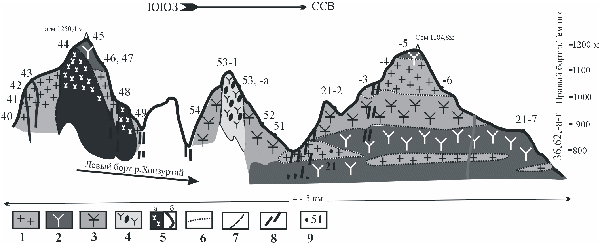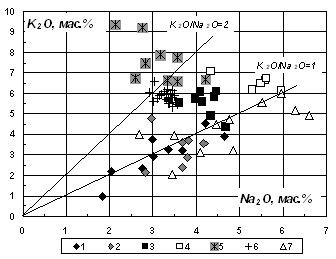|
POLYCHRONOUS SUBALKALINE MAGMATISM OF MALY KHAMAR-DABAN range (KHONZURTAY MASSIF) Institute of Geochemistry after Vinogradov S.B.RAS, Irkutsk, Russia, markiz@igc.irk.ru
Three stages of formation of anorogenic syenite-leucogranite series have been for the first time recognized in the Maly Khamar-Daban Range. Their products lie conjugate in the Temnik River low stream, within the Khonzurtay syenite-leucogranite massif, which is a polychromous formation, rather than just one intrusion. It was found that syenites of the first stage, making up a larger part of the massif, represent the products of crystallization differentiation of monzo-syenite magmas produced by mixing up to the complete homogenization of the lower crust acid and upper mantle basic melts. Crystallizaton of the end members resulted in formation of: (1) fine-, medium-grained bifeldspar leucogranites close in chemistry to À-type and (2) differentiated series of subalkaline gabbroids of OIB-type, at times associated with cumulative plagio-pyroxenites. Leucogranites occur among syenitoids as subhorizontal lenses of different (to some hundred meters) thickness with indistinct diffused contacts and occur at different hypsometric levels (Fig.1). Gabbro, commonly amphibolized and kalispasized, are commonly present only in the lowermost cross-section in different proportions with leucogranites (Kazimrovsky, 2007-à), sometimes producing subhorizontal transitional zones, some tens meters thick, in which the «layers» of hybrid rocks of monzosyenite composition are alternated. The differentiation of hybrid magmas initially resulted in crystallization of Cpyr (later replaced by Amf and Bi) and Pl, ànd then flotation of alkaline feldspar and accessory Sph and Zr, which eventually brought about formation of quartz syenites of varying alkalinity up to purely alkaline feldspar varieties with increased contents of K, Na, Al, Ti and HFSE and lowered Ñà, Mg, Ba, Sr, U, Th, REE, Y, Li, Be and F (Kazimirovsky, 2007-á). Preserved hybrid melanosyenites (kalispasized and biotized monzosyenites) occur as irregularly shaped fragments about 100 m across.
Fig.1. Geological cross-section of the central part of Khonzurtay massif. Legend: 1 – leucocratic granites; 2, 3 – rocks of stage I: 2 – quartz syenites; 3 – alkaline feldspar syenites; 4 – alkaline feldspar syenites of stage II with synplutonic basite nodules; 5 – rocks of stage III: à – alkaline granites; b – trachydacite-porphyry dykes; 6 – indistinct boundaries of leucogranites; 7 – supposed crossing boundaries between syenitoids of stages I and II, I and III stages; 8 – faults zones; 9 – sampling sites. The second stage is represented by thick (300-400 m) crossing bodies of porphyry-like quartz syenites with Amf rich in small round nodules of essentially kalispathized Amf-Pl gabbro (Fig.1). Above that, on its northern margin, on the left side of Temnik River more acid Cpyr-bearing granosyenites are exposed. They show rough irregularly outlined inclusions of the same gabbro, as well as composite granosyenite- and alkaline granite-basite dykes, gabbro-II having a much «fresher» petrographic look, than gabbro-I, and contain nearly not amphibolized Êpyr (Kazimirovsky, 2007-à). Leucogranites with granosyenites -II are rarely associated and occur as small thin lenses with diffuse contacts. As regards syenitoids of stage II, it seems that their parent acid components were the products of partial melting of both granite-metamorphic “frame” and leucogranites and quartz syenites formed at the first stage. Granosyenites-II are distinguished from the latter by the increased K/Na ratio (Fig. 2), higher concentrations of Ê and Rb, and low Na, Li, F, Ti, Zr, Hf and REE (Kazimirovsky, 2007-á).
Fig. 2. Diagram Na2O – K20 for rocks of Khonzurtay massif. Legend: 1 – gabbro-I; 2 – gabbrî-II; 3 – quartz syenites-I; 4 – alkaline feldspar quartz syenites-I; 5 – syenitoids-II; 6 – leucogranites; 7 – diabases, trachydacites, comendites and alkaline granites of stage III.
The third stage results in formation (Fig.1) of the bodies of alkaline granitoids and associations of dykes, e.g. diabase, trachybasaltic, trachydacitic and comendite. The mineral characteristics of rocks correspond to the well-known in the western Trans-Baikal Kunaley (Tsagan-Khurtey) volcano-plutonic complex of the Upper Triassic age (Dobretsov, 2003). Thus, it is reasonable to parallelize formations of stage II with the Permian-Triassic Kudunsky or Khorinsky after (Dobretsov, 2003), and stage I – with the Early Permian Lower Selenginsky after (Zanvilevich et al., 1991) or Bryansky after (Dobretsov, 2003) magmatic complexes. This requires the isotope-geochronological evidence. As to leucogranites, there are two varieties diffused into each other in the same cross-sections, irrespective of their general petrochemical affinity in exterior and rare-metal composition: 1. pinkish-grey with a high rare-metal load, 2. more leucocratic bright-pink with low concentrations of practically all groups of rare elements (particularly REE, Y, Th and U) including compatible elements Li, Zn, Ti, Fe and Co. Transitions between them are quite indistinct. It appears that the second variety was fused from the first one, which is associated with gabbro-I. Thus, our observations agree with the concept (Litvinovsky et al., 1999) on the conditions of formation of syenite magma of anorogenic series (model MFC) under the mantle plumes action (Dobretsov, 2003). The work is supported by RFBR grant ¹ 08-05-00403.
References Dobretsov N.L. Mantle plumes and their role in formation of anorogenic granitoids // Geol. & Geophys.. 2003. V.44. ¹12. P.1243-1261. Zanvilevich À.N., Kalmanovich Ì.À., Litvinovsky B.À., Posokhov V.F., Shadaev Ì.G. Early Permian stage of granitoid magmatism in Western Trans-Baikal area // Geol. & Geophys. V. F. 1991. ¹ 11. P.27-36. Kazimirovsky Ì.E. Synplutonic basites of the Late Paleozoic syenite-leucogranite complexes of Southern Pre-Baikal //Problems of geochmeistry of endogenous processes and environment. Irkutsk, 2007-à. V. 2.P.109-114. Kazimirovsky Ì.E. On the spatial overlap of different time stages of anorogenic magmatism of Mongolian-Trans-Baikal zone (Maly Khamar-Daban, Khonzurtay massif) // Geodynamic evolution of lithosphere of Central-Asian mobile belt (from ocean to continent). Issue.5. V.1. Irkutsk, 2007-á. P..95-98. Litvinovsky B.À., Zanvilevich À.N., Wickham S.Ì., Still E.Ì. Conditions of formation of syenite magma of anorogenic granitoid series: syenite-granite series of Trans-Baikal // Petrology. 1999. V.7. ¹ 5. P.483-508.
|

